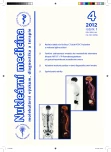Radiation dose to the eye lens from the CT portion of a PET/CT examination and possibilities of its reduction
Authors:
Jaroslav Ptáček () 1,2,3; Pavel Koranda () 2; Iva Metelková () 2,3
Authors‘ workplace:
Oddělení lékařské fyziky a radiační ochrany, Fakultní nemocnice Olomouc
1; Klinika nukleární medicíny LF UP a Fakultní nemocnice Olomouc
2; Ústav zobrazovacích metod FZV UP Olomouc
3
Published in:
NuklMed 2012;1:63-67
Category:
Original Article
Overview
Introduction:
PET/CT examination is vital for oncological patients nowadays. ICRP in its document Statement on Tissue Reactions ref 4825-3093-1464 proposes a new threshold of radiation absorbed dose in an eye lens for radiation induced cataract in the level of 500 mGy. It could be possible to achieve this value in a current clinical practice (especially during repeated CT examinations of a head). The goal of our study is to provide information about radiation dose to the eye lens from the CT portion of a PET/CT examination including possibilities of its reduction.
Material and methods:
We analyzed radiation absorbed dose to the eye lens in patients evaluated with a PET/CT in the Department of Nuclear Medicine of the University Hospital in Olomouc. Absorbed dose in the eye lens was determined for a PET/CT of a torso, brain, whole-body and for the CT used for attenuation correction. We evaluated 8 patients for calculation the dose from a torso and a whole-body examination including a head, respectively. Only one study was used for the dose calculation during a brain examination and an attenuation correction, respectively.
Results:
Eye lens radiation absorbed dose calculated by ImPACT program was 6 mGy, 3.7 mGy, 49 mGy and 1.4 mGy during examination of a torso, whole-body, brain and during attenuation correction examination, respectively.
Conclusion:
Our calculated values are in accordance with a literature. The highest eye lens radiation absorbed dose is from the brain examination. However, like in ther cases, it is still far under the threshold for a radiation induced cataract.
Key Words:
PET/CT, radiation absorbed dose, eye lens
Sources
1. ICRP. Statement on Tissue Reactions. 2011; ICRP ref 4825-3093-1464
2. Klener V (ed.). Principy a praxe radiační ochrany. Praha, Státní úřad pro jadernou bezpečnost, 2000
3. Schilham A, van der Molen AJ, Prokop M et al. Overranging at Multisection CT: An Underestimated Source of Excess Radiation Exposure. RadioGraphics 2010;30:1057-1067
4. Rehani MM, Berry M. Radiation doses in computed tomography. The Increasing doses of radiation need to be controlled. BMJ 2000;320:593-4
5. Task Group on Control of Radiation Dose in Computed Tomography, Managing patient dose in computed tomography: a report of the International Commission on Radiological Protection. Ann ICRP 2000;30:7-45
6. Zammit-Maempel I, Chadwick CL, Willis SP. Radiation dose to the lens of eye and thyroid gland in paranasal sinus multislice CT. BJR 2003;76:418-420
7. Bassim MK, Ebert CS, Sit RC et al. Radiation Dose to the Eye and Parotids During CT of the Sinuses. Otolaryngology-Head and Neck Surgery 2005;133:531-533
8. Conhen M, Wittsack HJ, Assadi S, et al. Radiation Exposure of Patients in Comprehensive Computed Tomography of the Head in Acute Stroke. Am J Neuroradiol 2006;27:1741-1745
9. Tan JSP, Tan KL, Lee JCL et al. Comparison of Eye Lens Dose on Neuroimaging Protocols between 16- and 64-Section Multiditector CT: Achieving the Lowest Possible Dose. Am J Neuroradiol 2009;30:373-377
10. Jaffe TA, Hoang JA, Yoshizumi TT et al. Radiation Dose for Routine Clinical Adult Brain CT: Variability on Different Scanners at One Institution. AJR 2010;195:433-438
11. Michel M, Jacob S, Roger G et al. Eye lens radiation exposure and repeated head CT scans: A problem to keep in mind. Eur J Radiol 2011, doi:10.1016/j.ejrad.2011.03.051
12. Hall P, Granath F, Lundell M et al. Lenticular opacitites in individuals exposed to ionizing radiation in infancy. Radiat Res 1999;152:190-5
13. Rehani MM, Vano E, Ciraj-Bielac O et al. Radiation and cataract. Radiat Prot Dosimetry 2011;147(1-2):300-304
14. Chiewvit P, Ananwattanasuk J, Mongkolsuk M et al. Evaluation of Image Quality and Len`s Radiation Dose of a Low-Dose Cranial CT Scan. J Med Assoc Thai 2009;92(6):831-5
15. Niu Y, Wang Z, Liu Y et al. Radiation Dose to the Lens Using Different Temporal Bone CT Scanning Protocols. Am J Neuroradiol 2010;31:226-229
16. Recommendation by the German Commission on Radiological Protection. Patient Radiological Protection in Cranial Computed Tomography (Gantry Tilt) [online]. April 2011. [cit. 2012-11-08]. Dostupné na: http://www.ssk.de/SharedDocs/Beratungsergebnisse_PDF/2011/2011_03e.pdf?__blob=publicationFile
17. McLaughlin DJ, Mooney RB. Dose reduction to radiosensitive tissues in CT. Do commercially available shields meet the users’ needs? Clinical Radiology 2004;59:446-450
18. Mukundan S, Wang PI, Frush DP et al. MOSFET Dosimetry for Radiation Dose Assessment of Bismuth Shielding of the Eye in Children. Am J Radiol 2007;188:1648-1650
19. Raissaki M, Perisinakis K, Damilakis J et al. Eye-lens bismuth shielding in paediatric head CT: artefact evaluation and reduction. Pediatr Radiol 2010;40:1748-1754
20. Zizka J, Jandura J, Kvasnicka T et al. Reduction of effective and organ dose to the eye lens in cerebral MDCT scans using iterative image reconstruction [online]. [cit. 2012-11-08]. Dostupné na: http://www.rsna.org/uploadedFiles/RSNA/Content/News/NewsArticle/2012/July/ECR2012_CT_brain_Zizka.ppt
Labels
Nuclear medicine Radiodiagnostics RadiotherapyArticle was published in
Nuclear Medicine

2012 Issue 4
Most read in this issue
- Assessment of brain perfusion as a part of brain death diagnosis – case reports
- Radiation dose to the eye lens from the CT portion of a PET/CT examination and possibilities of its reduction
- Funkčné zobrazovacie metódy ako metabolická alternatíva biopsie: PET/CT s 18F fluorodeoxyglukózou pri gastrointestinálnom stromálnom tumore
- Issues of cataract due to ionizing radiation
